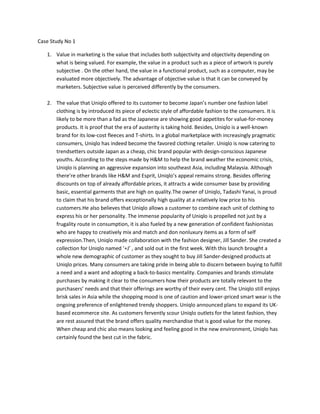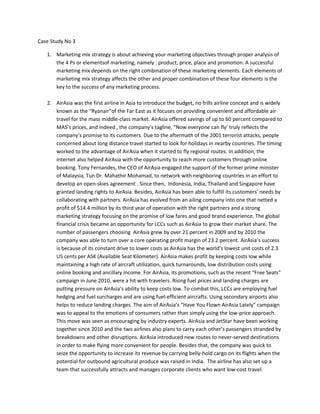Case study no 1
- 1. Case Study No 1 1. Value in marketing is the value that includes both subjectivity and objectivity depending on what is being valued. For example, the value in a product such as a piece of artwork is purely subjective . On the other hand, the value in a functional product, such as a computer, may be evaluated more objectively. The advantage of objective value is that it can be conveyed by marketers. Subjective value is perceived differently by the consumers. 2. The value that Uniqlo offered to its customer to become JapanˇŻs number one fashion label clothing is by introduced its piece of eclectic style of affordable fashion to the consumers. It is likely to be more than a fad as the Japanese are showing good appetites for value-for-money products. It is proof that the era of austerity is taking hold. Besides, Uniqlo is a well-known brand for its low-cost fleeces and T-shirts. In a global marketplace with increasingly pragmatic consumers, Uniqlo has indeed become the favored clothing retailer. Uniqlo is now catering to trendsetters outside Japan as a cheap, chic brand popular with design-conscious Japanese youths. According to the steps made by H&M to help the brand weather the economic crisis, Uniqlo is planning an aggressive expansion into southeast Asia, including Malaysia. Although thereˇŻre other brands like H&M and Esprit, UniqloˇŻs appeal remains strong. Besides offering discounts on top of already affordable prices, it attracts a wide consumer base by providing basic, essential garments that are high on quality.The owner of Uniqlo, Tadashi Yanai, is proud to claim that his brand offers exceptionally high quality at a relatively low price to his customers.He also believes that Uniqlo allows a customer to combine each unit of clothing to express his or her personality. The immense popularity of Uniqlo is propelled not just by a frugality route in consumption, it is also fueled by a new generation of confident fashionistas who are happy to creatively mix and match and don nonluxury items as a form of self expression.Then, Uniqlo made collaboration with the fashion designer, Jill Sander. She created a collection for Uniqlo named ˇ®+JˇŻ , and sold out in the first week. With this launch brought a whole new demographic of customer as they sought to buy Jill Sander-designed products at Uniqlo prices. Many consumers are taking pride in being able to discern between buying to fulfill a need and a want and adopting a back-to-basics mentality. Companies and brands stimulate purchases by making it clear to the consumers how their products are totally relevant to the purchasersˇŻ needs and that their offerings are worthy of their every cent. The Uniqlo still enjoys brisk sales in Asia while the shopping mood is one of caution and lower-priced smart wear is the ongoing preference of enlightened trendy shoppers. Uniqlo announced plans to expand its UK- based ecommerce site. As customers fervently scour Uniqlo outlets for the latest fashion, they are rest assured that the brand offers quality merchandise that is good value for the money. When cheap and chic also means looking and feeling good in the new environment, Uniqlo has certainly found the best cut in the fabric.
- 2. Case Study No.2 1. Ray Kroc preached a motto of QSCV-quality, service, cleanliness and value. These goals became mainstays in McDonaldˇŻs customer-focused mission statement. The company is perfected the fast-food concept-delivering convenient, good-quality food at affordable prices. The companyˇŻs mission was changed from ˇ°being the worldˇŻs best quick-service restaurantˇ± to ˇ°being our customersˇŻ favorite place and way to eatˇ± in early 2003. 2. In the mid-1990s, McDonald appeared to fall out of touch with both its mission and its customers. Americans were looking for better and healthier food. McDonaldˇŻs seemed a bit out of steps with times. As McDonaldˇŻs was struggling to find its identity amid flurry of new competitors and changing consumer tastes. But none of their ideas worked. But McDonaldˇŻs continued opening new restaurants as many as 2000 per year. Even the new stores helped sales, customer service and cleanliness declined because the company couldnˇŻt hire and train good workers fast enough. Meanwhile, McDonaldˇŻs increasingly became a target for animal-rights activists,environmentalists, and nutritionists, who accused the chain of contributing to the nationˇŻs obesity epidemic with ˇ°super sizeˇ± French fries and sodas as well as Happy Meals that lure kids with the reward of free toys. The once shiny Golden Arches lost some of their luster although McDonaldˇŻs remained the worldˇŻs most visited fast-food chain. In 2002, the company posted its first-ever quarterly loss. The company had lost sight of its fundamental value proposition. As a result, the company and its mission needed to adapt. In early 2003, McDonaldˇŻs announced a turn around plan-what it now calls its ˇ°Plan to Winˇ±. This plan was a new mission statement that refocused the company on its customers. According to the analyst, the companyˇŻs mission was changed from ˇ°being the worldˇŻs best quick-service restaurantˇ± to ˇ°being our customersˇŻ favorite place and way to eat.ˇ± ItˇŻs all centered on five basics of an exceptional customer experience: people, products, place, price and promotion. The plan, and the seemingly simple shift in mission, forced McDonaldˇŻs and its employees to focus on quality, service, and the restaurant experience. The goal was to get ˇ°better, not just biggerˇ±. Since its Plan to Win announced, McDonaldˇŻs sales have increased by more than 50 percent and profits have more than quadrupled. When the stock market lost one-third of its value, McDonaldˇŻs stock gained nearly 6 percent, making it one of only two companies in the Dow Jones Industrial Average whose share price rose during that year. McDonaldˇŻs outperformed its competitors by a notable margin and achieved a lofty 15.5 percent three year compound annual total return to investors versus the S&P 500 average of ¨C 5.6 percent. Now, McDonaldˇŻs appears to have the right mission for the times.
- 3. Case Study No 3 1. Marketing mix strategy is about achieving your marketing objectives through proper analysis of the 4 Ps or elementsof marketing, namely : product, price, place and promotion. A successful marketing mix depends on the right combination of these marketing elements. Each elements of marketing mix strategy affects the other and proper combination of these four elements is the key to the success of any marketing process. 2. AirAsia was the first airline in Asia to introduce the budget, no frills airline concept and is widely known as the ˇ°Ryanairˇ±of the Far East as it focuses on providing convenient and affordable air travel for the mass middle-class market. AirAsia offered savings of up to 60 percent compared to MASˇŻs prices, and indeed , the companyˇŻs tagline, ˇ°Now everyone can flyˇŻ truly reflects the companyˇŻs promise to its customers. Due to the aftermath of the 2001 terrorist attacks, people concerned about long distance travel started to look for holidays in nearby countries. The timing worked to the advantage of AirAsia when it started to fly regional routes. In addition, the internet also helped AirAsia with the opportunity to reach more customers through online booking. Tony Fernandes, the CEO of AirAsia engaged the support of the former prime minister of Malaysia, Tun Dr. Mahathir Mohamad, to network with neighboring countries in an effort to develop an open-skies agreement . Since then, Indonesia, India, Thailand and Singapore have granted landing rights to AirAsia. Besides, AirAsia has been able to fulfill its customersˇŻ needs by collaborating with partners. AirAsia has evolved from an ailing company into one that netted a profit of $14.4 million by its third year of operation with the right partners and a strong marketing strategy focusing on the promise of low fares and good brand experience. The global financial crisis became an opportunity for LCCs such as AirAsia to grow their market share. The number of passengers choosing AirAsia grew by over 21 percent in 2009 and by 2010 the company was able to turn over a core operating profit margin of 23.2 percent. AirAsiaˇŻs success is because of its constant drive to lower costs as AirAsia has the worldˇŻs lowest unit costs of 2.3 US cents per ASK (Available Seat Kilometer). AirAsia makes profit by keeping costs low while maintaining a high rate of aircraft utilization, quick turnarounds, low distribution costs using online booking and ancillary income. For AirAsia, its promotions, such as the recent ˇ°Free Seatsˇ± campaign in June 2010, were a hit with travelers. Rising fuel prices and landing charges are putting pressure on AirAsiaˇŻs ability to keep costs low. To combat this, LCCs are employing fuel hedging and fuel surcharges and are using fuel-efficient aircrafts. Using secondary airports also helps to reduce landing charges. The aim of AirAsiaˇŻs ˇ°Have You Flown AirAsia Latelyˇ± campaign was to appeal to the emotions of consumers rather than simply using the low-price approach. This move was seen as encouraging by industry experts. AirAsia and JetStar have been working together since 2010 and the two airlines also plans to carry each otherˇŻs passengers stranded by breakdowns and other disruptions. AirAsia introduced new routes to never-served destinations in order to make flying more convenient for people. Besides that, the company was quick to seize the opportunity to increase its revenue by carrying belly-hold cargo on its flights when the potential for outbound agricultural produce was raised in India. The airline has also set up a team that successfully attracts and manages corporate clients who want low-cost travel.
- 4. Because of its success, AirAsia started to open many offerings based on the low-cost business model.




